#and like off topic from this meta but it simply cannot be a coincidence that the guardian of
Text


while listening to kas talk to me about their ahri portrayal, they inspired me to elaborate a lil' more on her ritualisms; therein, the manner in which she ornaments her cadavers post-feeding. i've spoken on this meta a million and two times in the past, as it's been an integral part of her character for almost as long as i've written her ━━━━ and a shard of my portrayal that i hold very dear. so, i won't ramble too much about that!
but i did want to touch on the very purposeful reasoning behind ahri performing this act & the variations she has in it.
as a devotee to the all mother, and keeper of her design, the fox finds profound meaning in every blade of dewy grass and whistle of the wind between tree boughs, and the rot of death gently sheathed in blankets of moss and soil. there is symbolism spun like intertwining threads amongst every facet of nature; no matter how small & insignificant or forthright & proud. it all has a purpose, something to speak into the world around it. this is why she guards her domain so fiercely, in protection of what is inherently good and giving without fault.
「 the forest of the one - thousand faced fox is where nature sprawls unto to thrive, and where lost souls go to find beastly penance. 」
this is also why the kkoch-ui janglyesig, or ❛ funeral of flowers ❜ ritual is also a tribute to the soul it's vessel once contained. in respecting the feminine entity that is the forest, ahri must respect the souls that wander beyond the boundaries of her realm ━━━━ that is, if she deems them so fit to guide gently and with honor into the spirit realm. after all, there are many instances of those who taste of ash & rot that challenge the fox in her own arena whom far from deserve a garland of flowers but rather the maw of hungry wolves.
all this is to say that ahri is keenly aware of the meaning bestowed upon particular flora, and takes note of this whilst adorning her prey in moss and flowers. knowing this, ahri makes an effort to impart these meanings onto those who pass in her forest. ( the particular flowers needed are not always readily available, but nonetheless she makes an effort in the name of sanctification ).
although ahri would never harm a child, it is a sorrowful fact in a war-ridden world that she must guide their souls beyond the natural realm and into the spiritual, at times. in this case, ahri delicately blankets them in nature and bestows upon them 𝐖𝐇𝐈𝐓𝐄 𝐋𝐈𝐋𝐈𝐄𝐒 & 𝐋𝐈𝐋𝐈𝐄𝐒 𝐎𝐅 𝐓𝐇𝐄 𝐕𝐀𝐋𝐋𝐄𝐘.

they represent innocence and purity, as does the soul of a child; deserving only of safe passage into the warmth of the spirits beyond. if their soul should linger, perhaps forlornly shackled to the corporeal plane still, ahri will not consume it but delicately pull it from where it remains and dip it back into the all-encompassing, ethereal ocean of souls where it may find peace. after all, this is as simple a task as drawing her foxes fire from the intangible.
the most frequent of unwelcome visitors are lost travelers and merchants seeking out a lesser walked shortcut on their journey. as if tying the knot of their own fate, ahri then deems them fair hunt for their intrusive presence. these are the souls she will consume with minor remorse ━━━━ though that's not to say it's without none, as ahri has a deep-rooted appreciation for human nature and human emotion, and the short bursts of life they carry. under normal circumstances, the fox does not desecrate her prey without reason.
therefore, once the hunt is over, she will impart on them 𝐁𝐔𝐓𝐓𝐄𝐑𝐂𝐔𝐏𝐒 & 𝐖𝐈𝐋𝐃𝐅𝐋𝐎𝐖𝐄𝐑𝐒.

representing invasiveness, they are the most straight-forward form of symbolism when used; it is also most common to find her corpses embedded with this particular brand of flora, and the one she's become most known for in the surrounding areas and towns that have likened her to a dangerous mythos.
now, it's rare for ahri to even consider bestowing those she would tear to ribbons without a second thought with her ritual. but in very rare instances, she might. this is particularly true for souls she may feel are wrong and corrupt, but perhaps simply had a bad draw in life or their hand was forced. this opinion is typically formed post-feeding, as their memories and experiences and emotions crawl through-out the crevices of her mind. ahri is not without complex nuance in these situations; she is capable of benevolence in the face of rotten souls. it is simply ... infrequent.
for these, if ahri should bother looking for them, 𝐀𝐂𝐎𝐍𝐈𝐓𝐄 & 𝐁𝐔𝐓𝐓𝐄𝐑𝐅𝐋𝐘 𝐖𝐄𝐄𝐃 are used. the former, though can be equated to the first blush of spring and rebirth, is also highly toxic despite this. it is a reminder that there can be grim darkness in the once clean human soul. the latter is known to symbolize rejection, or serve as warning to others to stay away; it is without subtlety that ahri uses this in bushels.
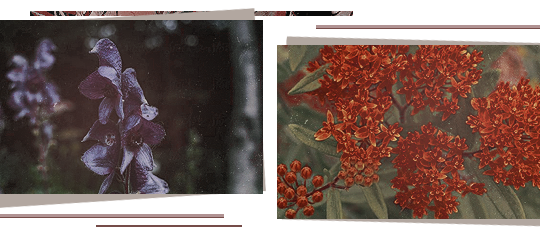
of course, an abundance of other flora and foliage is utilized in her rituals as the end purpose is to relinquish their physical forms to the omikayalan⁰¹, but there are consistencies between particular souls. the flowering ritual is something ahri holds dear to her heart and is not only a form of metaphorical prayer but a means of returning what once was to where it came from, preserving the natural circle of life.

#𝐓𝐇𝐄 ⠀⠀(⠀ⅴ.⠀)⠀⠀𝐌𝐄𝐓𝐀:⠀⠀ಇ⠀⠀sit and sing in the darkˏ arched marrow of me.#⁰¹ ━ omikayalan: heart of the world; or 'god-willow'. a sacred landmark of her species & the origins of all nature.#also known as: the all mother & the feminine nature.#remind me to write more meta on omikayalan because. it means so much to me & my portrayal of ahri.#her lore is so heavily heavily rooted in it.#and like off topic from this meta but it simply cannot be a coincidence that the guardian of#the god-willow sapling is also a giant nine-tailed fox! okay!#anyway ahri the cadaver florist making corpses pretty.
4 notes
·
View notes
Note
The Zeke problem seems to be a meta problem from Yams. It seems to me Isayama doesn't know how to solve the Zeke being killed (cheap) fanservice AND make Falco fly at the same time without even eating the Beast Titan. Its like Isayama is struggling with what to do with Zeke, and you cannot give ethic lessons in your manga whole trying to figure out a way to kill Zeke. I believe Zeke will join Levi, but his delayed presence in the manga looks more like Isayama scared to actually develop Levi
Sorry for the long post, I am mostly rambling. I agree that it is a meta problem on Isayama’s part.
He is especially having troubles with his characters in this final arc, I feel. Aside from the fact that he admitted he doesn’t know what actions the characters will take, which is...uh, weird, because it means he doesn’t have a clear vision for each character arcs, or isn’t especially thinking about their overall meaning, in my opinion, and it shows... Well, aside from that, I feel like Isayama has been struggling with showing a natural development for all his characters, as of late.
Particularly, the ending of the characters who have already received one has been all over the place, or not properly set up most of the times. I’m talking about the most recent deaths of Magath, Hange and Shadis, which felt more like ISYM didn’t have a use for these characters in future chapters, so he just conjured some rushed message up, quickly wrapped them in it, and got rid of them. In particular, I got this feeling with Magath, but mostly with Hange - the author didn’t know how to keep Hange in the story, so he offed them to benefit the vision he had for another one (Armin).
The same happened with Porco, who seemed to “be” a character mostly because someone had to inherit the Jaw long enough for them to pass it, at one point, to Falco, but I’ll give Isayama that at least Porco wasn’t a part of the story since the beginning as Hange was, and his death felt very fitting for his character.
Isayama has always had problems with endings, though, and I mean with ending a character’s life: just think back on Mike, whom, he admitted, he killed off too soon; Ymir, one of the most interesting characters in my opinion, who got offed off-screen for the simple reason that she knew too much at a moment where ISYM didn’t want to reveal certain cards. Bertolt’s death (or rather, the aftermath) was also treated poorly.
The remaining cast has also been suffering from a lack of steady, organic character development:
Mikasa was written in a way that won’t allow her development until she confronts Eren, so she’s been mostly on stand-by for a whole arc.
Armin, similarly, isn’t changing at all, is constantly faced with chances to grow and overcome certain setbacks, but it’s obvious this will happen only when he will face Eren head-on. His deathwish (ch.126?) was never developed and was sprung on us for dramatic effect - contrary to Reiner’s, which felt organic and had good built-up.
But Reiner’s arc in itself is all over the place too, in my opinion, though it’s marginally better than others.
Half of Connie’s plot line (avenging his family by killing Zeke) has been canceled out of the story because I suppose it would be too bothersome for Isayama to write, and the remaining half was resolved in one chapter, in a cheap and cheasy way that felt like snuffing out a candle after seeing it burn for a while. “Dark!Connie” was a super interesting concept, a natural development since Clash of the Titan arc, his indignation and pain finally reaching a peak gave a breath of fresh air to such a background character. Such a shame.
Levi has been stuck on the same few lines and opinions for the whole arc, being offered some chances of self-reflection, but getting nothing, no change out of it (though this is a constant in his character arcs and it feels very awkward). A big chunk of who he was was also reduced to the barest of bones.
Historia... well... her few appearances barely had any agency, and the parts where she was allowed to speak were an incoherent mess that still needs explaining. Many feel she was reduced to a plot device, which is very poor writing if most of the fanbase feel this way about such a great character.
Hange, again, was presented with a VERY interesting dilemma, and it was solved (more like, a resolution was avoided) by offing them.
Sasha was used for thematical moments, and killed for it.
Gabi IS a thematical character, so her presence was rather compelling after all, though at times her character arc was so on the nose it felt awkward.
Annie...I’m unsure. She was kept out of the story until the last moment only to have a very interesting crisis, culmination of her many struggles, from when the series had solid characters, only to muddle it with uncalled-for romance, that wasn’t even particularly impactful on any of the characters involved. I used to think romance in this manga had purpose and enriched the characters, taking yumihisu as the only example, but I was wrong, and it’s just some cheap little drama.
Eren...his development has been so obscure and his behavior so out of left field and confusing, that the fandom - and Isayama - have said it’s the new mystery of the story.
All this to say that Character consistency and plausibility have been suffering for the whole arc. Zeke’s writing, in retrospect, has been consistent. ISYM has set up some interesting themes, dilemmas and ideas with him, as well as a natural progression and built up to a solution to them, but he’s stalling in their resolution, or rather, actualization.
Maybe it’s because there are too many characters, maybe it’s because he needs to get to the point Zeke can be relevant again, but compared to other characters’ treatment, I find the stalling re:Zeke way more believable, as it started the moment his existence was overcome by Eren’s in Paths. Other characters, who should play an active role, are simply moved from one point to the next with barely any real “content” to them and their psychology.
tl;dr: Isayama set them up to follow a certain direction, but he’s struggling with its delivery, because he had to stall it in order to make it happen at the right moment - which coincides with the end. But this makes them appear static and weak presences in the story, and the plot a chore that has to be painstakingly unraveled. Characters and plot aren’t working as a single unit.
Going back quickly to the issue between Zeke and Levi, I haven’t had the impression Levi will get what he wants in regards to Zeke since Zeke escaped the very first time in Shiganshina. So I am not sure if it’s been my wishful thinking all along, or what, but I have always thought the fandom is drunk and should go home about this particular topic XD I don’t think ISYM is setting up Levi to kill Zeke, at least not in the way that the fandom (and Levi) wishes. Hints that it cannot happen have always been stronger than the opposite, to me.
But I will say that everyone’s behavior towards Zeke is written very weirdly - I mean, they allied and could find it in themselves to mostly forgive Reiner and Annie (AND PIECK! why does nobody acknowledge what Pieck did?!) even though 20 chapters ago they brought an all out attack from Marley to Paradis, and yet, even if they know what Zeke went through, they cannot spare a single humanizing thought about him. Maybe it’s because of his plan, but I cannot imagine is worse than Marley and Reiner calling for Paradis extintion or Eren for the world’s. So I cannot tell if it’s a meta issue (Isayama’s messy writing) or if he’s purposely potraying them to be hypocrites, or if it’s just a very awkward transition that needs to happen between “using Zeke as a scapegoat” and “acknowledging that it’s Eren that needs to be stopped directly, no easy escape route on this”.
32 notes
·
View notes
Text
The Underlying Christian Symbolism in Undertale: Asriel’s Messianic Parallels
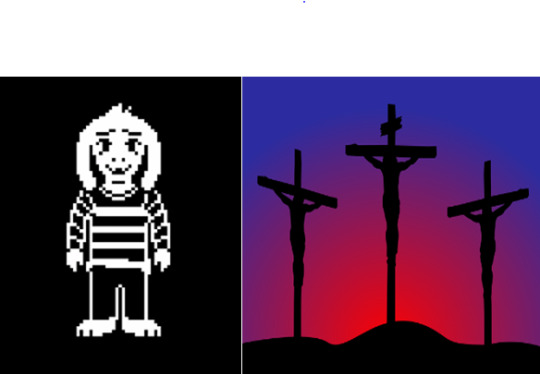
Yesterday we talked about the Devil, so today we’re talking about Christ. Or at least, I should say, Christ-like characters in Undertale. I’m referring of course to Asriel Dreemurr. Despite the brevity of time he actually spends on screen, Asriel is easily one of the most endearing and heartbreaking characters in the entire game, and for Undertale, that’s saying something. Judging from the amount of fan art and fan fictions dedicated to him, he’s left more of an impact on the fanbase than any other character with the exception of Sans. It’s not hard to see why; many consider him to be the purest embodiment of love, pacifisms, and selflessness in the game, yet he’s been dealt the most tragic lot of any of the characters. Effectively, Asriel is the one person you cannot save. But beyond the obvious general parallels of the two figures, is this there something more to this sweet and tragic goat boy than meets the eye?
I’m of the opinion there is. Finding religious subtexts in video is always a slippery and volatile subject, but in this case, I can’t shake the feeling that the parallels are too pointed to ignore. I don’t think Asriel was meant to be a direct analogue to Jesus in the way characters such as Aslan from the Chronicles of Narnia are. But I find it hard to believe that his character wasn’t at least inspired by Christ, and hopefully by the end of this post you’ll see what I mean.
The first encounter we could say we have with Asriel is at the very beginning of the game in the form of Flowey. However, there seems to be some debate amongst the fanbase as to whether Asriel and Flowey can even be considered the same character, so polar opposite are their personalities. King Asgore may look like a devil, but Flowey is the closest thing the Underground has to an actual demon in terms of what he does. Much like the Fallen Child, he often works vicariously through others, using temptation and manipulating to coerce people into furthering his plans. Also like the Fallen Child, Flowey is soulless, and thus incapable of feeling love for others. The “Asriel” side of him only re-emerges in the presence of the souls that allowing him to feel compassion once more. Just for that reason alone, I’m going to be treating Asriel and Flowey as separate characters throughout this post, the same way I would consider the entity we meet at the end of the Genocide Route to be something distinct from the original First Child who fell into the Underground. However, that being said, it’s interesting to note that the first and the being we fight is always either Flowey or Asriel, whether one is doing a pacifist, neutral, or genocide playthrough. One way or another, the Flowey/Asriel entity acts as bookends to the entire game and seems to exist on a more meta level than the rest of the cast, when we listen closely to their dialogue.
First, here are a couple of the more superficial parallels between Asriel and Jesus. Both of them are described as the only naturally born son of a king, but are also described as having adopted siblings, and both are held up as great symbols of hope at their birth. Both at some point claim to be God. Despite this, both of them appear to bring great tragedy and hardship to the lives of all who love them, at least at first. Asriel is very compassionate and gentle to others; the story of how he treated the First Human child could be described as a textbook example of the Good Samaritan. Both figures die unjustly at the hands of their enemies, refusing to fight back despite having the ability to destroy everyone who was harming them. Also, curiously, the name “Asriel” can mean “Prince of God”, in addition to being a portmanteau of the names Asgore and Toriel. This very name is actually used in the Bible for one of the sons of Manasseh, so if it sounds Hebrew in origin, that’s because it is.
From there the similarities start to deepen. Both Asriel and Jesus have prophecies that refer to them. For Asriel, it’s the Delta Rune that’s said to predate written history, according to Gerson. The Delta Rune is probably going to get its own post at some point because of how packed it is with brilliant symbolism, so I’ll try to be brief here.
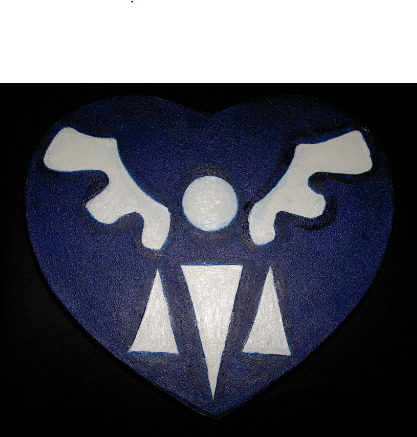
To put it simply, the Delta Rune is the symbol of an “angel” from above who will cause the underground to go empty, whether by freeing all monsters or by killing all of them. There’s some debate as to who exactly this “angel” is, many would believe it was the player, and in the genocide run, it very well might be. On the pacifist, run, however, the “angel” definitely aligns most closely with Asriel, and the reflection of the Delta Rune’s design in his final form is evidence of this (note the location of the triangles on his body) This is really the only prophecy we know of that links to Asriel directly, but it’s still a prophecy nonetheless.

Ultimately, Asriel is the one who breaks the barrier and sets all monsters free from the Underworld. Not only this, but he does so at the cost his own life, giving up the souls and reverting back to a flower. If I really have point out to you why this would be reminiscent of Christ, then this blog probably isn’t your cup of tea. But that’s not all. Right before the barrier is shattered, Asriel’s spite rises off of the ground and takes a very particular stance before committing the act. He begins speaking some inaudible words as the souls rush out of him and a really dramatic guitar riff starts playing in the background. But take a close look at that pose. Does it remind you of anything?
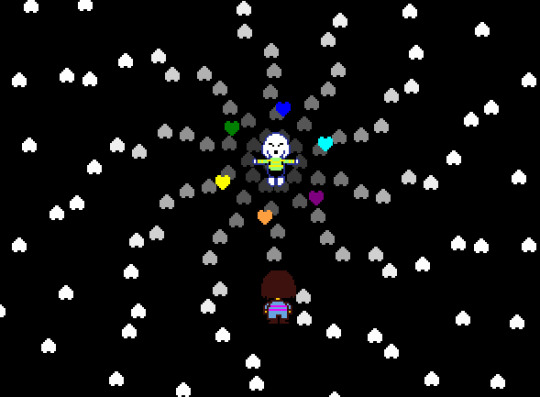
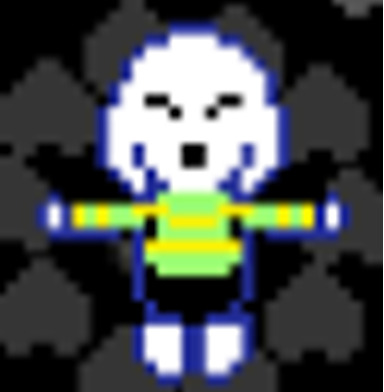
There are some other peculiarities in the following scenes that seem to call back on New Testament imagery. One is the actual depiction of the barrier being shattered. It appears as a white screen cracking in two and the halves separating, before the message “The barrier was destroyed” flashes across the screen. It’s hard to say what exactly most of us were expecting we would see when we witnessed the destruction of the barrier, but I have to imagine that most of us saw this as a very minimalistic approach, almost a letdown, really, to such a dramatic event.
Or was it?
I can’t help but look but look at this picture of the barrier being destroyed and not be a little reminded of Matthew 27:50-51, “And when Jesus had cried out again in a loud voice, he gave up his spirit. At that moment the curtain of the temple was torn in two from top to bottom. The earth shook, the rocks split, and the tombs broke open.”
Anyone who’s done their theological homework knows that the curtain in the Jewish Temple was a symbol of the separation of God’s holiness and the sins of humanity. In effect, it acted as a barrier between man and God. And with the death of Jesus, that barrier of separation is destroyed. This symbolism wasn’t lost on the New Testament writers, it’s actually quite explicit. Ephesians 2:14 reads “For he [Christ] himself is our peace, who has made the two groups one and has destroyed the barrier, the dividing wall of hostility.”
Is this starting to get weird yet? Maybe up to this point, I still that all of this could just be a big coincidence, an unlikely set of parallels to the Bible that a video game happens to exhibit, perhaps because these Biblical archetypes are just so ubiquitously ingrained in our culture. And who knows, maybe that’s all it is.
But there is one more detail.
I don’t remember when exactly it was I began to suspect that Undertale might have religious themes woven into its subtext. But perhaps it was around the point I started noticing the subtle topics of death and resurrection within the story, and their connection to the “soul”. The Fallen Child Chara apparently resurrects at the end of the genocide run (though whether that entity is actually Chara seems doubtful). Also, they appear to be communicating within the mind of Frisk, narrating the events on the screen as they happen, leading some to believe that Frisk is actually the reincarnation of Chara. Asriel himself undergoes a twofold resurrection within the game, first as a soulless flower at the hands of Dr. Alphys, and later back to his full being with the absorption of the human souls.
And then, there are the six other humans who fell underground.
There are a lot of unanswered mysteries in Undertale, but one of the ones I find the most puzzling is the question of what happened to the human souls when Asriel gave them up to break the barrier? Did they dissipate, were they taken to the afterlife, or did something…else…happen to them? There’s a hint in the game, but it raises more questions than answers.
If you go past the throne room in Asgore’s palace, you will find a set of stairs leading to his basement. If you follow them all the way down, you will find this room:
If you try to look into the coffin you find the name of the first human on it, also with the description that it’s empty. By logical extension, the other coffins are the six other children.
If you go back to the basement after having saved Asriel, when the barrier is broken, you find this:

All of the tombs are empty and all save the first one are open.
Let’s go back to Matthew 27 for a second. If we keep reading from where we left off; “…At that moment the curtain of the temple was torn in two from top to bottom. The earth shook, the rocks split, and the tombs broke open. The bodies of many holy people who had died were raised to life. They came out of the tombs after Jesus’ resurrection and after Jesus’ resurrection they went into the holy city and appeared to many people.”
Uncanny, isn’t it? Why are all the coffins open except for the one already stated to be empty? Where are the bodies? And where is the body of the First Child? Are they really dead?
We never get any answers, but if you go to check the coffin again, you’ll find the message “The coffin is empty…? You didn’t notice it before, but there’s something like…mummy wrappings at the bottom of it.”
Most likely these would be grave clothes, or perhaps a shroud. But this seems like an awfully insignificant detail to slip into a room so filled with unanswered questions. All it really tells is that the body isn’t in the coffin anymore. And it wasn’t reburied somewhere else, since the grave clothes were taken off. Does this also sound familiar?
“So Peter and the other disciple started for Jesus’ tomb. Both were running, but the other disciple outran Peter and reached the tomb first. He bent over and looked in at the strips of linen lying there but did not go in. Then Simon Peter came along behind him and went straight into the tomb. He saw the strips of linen lying there, as well as the cloth that had been wrapped around Jesus’ head. The cloth was still lying in its place, separate from the linen. Finally the other disciple, who had reached the tomb first, also went inside. He saw and believed.” (John 20:4-8)
So, what are we to make of this? It’s not uncommon for stories or video games to involve a Messianic archetype, but the detail of symbolism used in this case suggests there might be something more going on with Asriel than your usual stock redeemer character. Coupled with Asriel’s father’s resemblance to Satan, Asriel’s flower alter ego playing a much more actual Satanic character, and the fact that this boy is the one person you CAN’T save, but who essentially dies AFTER resurrecting in the “friendly RPG where no one has to die”, this mystery of Undertale lends itself to some rather confusing, and frankly disturbing, implications.
Stay safe, folks. Until next time, this is Truecantaloupelove, signing off.
8 notes
·
View notes